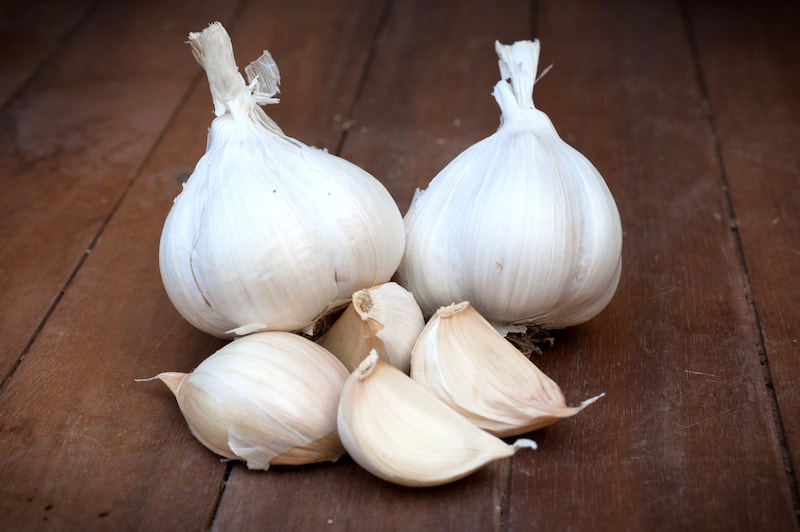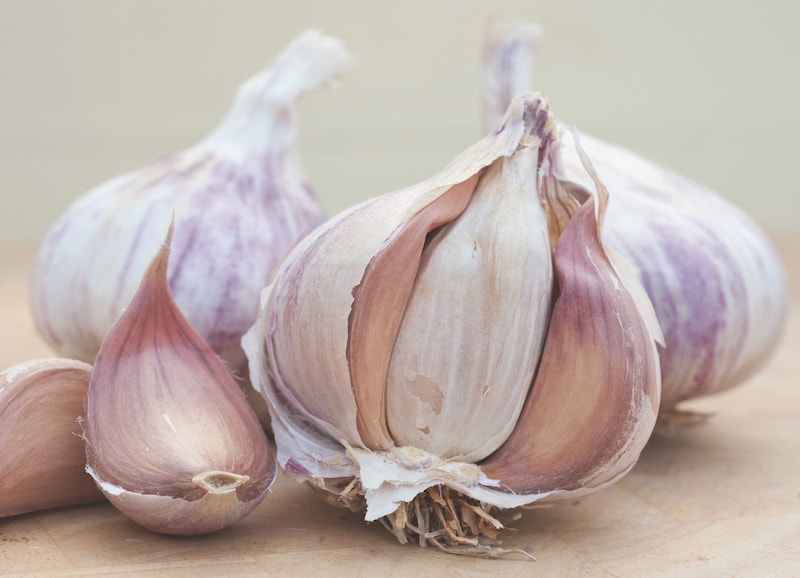Autumn planting your garlic means this aromatic mediterranean allium is well set for strong early growth during the spring and will be ready to harvest earlier in the summer. Here’s how to prepare the ground for your winter garlic, along with how to plant, care for and store your crop once it’s ready to harvest.
Keen to have a go? Browse our full range of autumn planting garlic bulbs to choose from flavoursome soft neck and hard neck varieties.
Which garlic should I plant?

One of the most versatile hardneck varieties, Kingsland Wight can be planted in autumn or early spring
Image: Garlic Bulbs ‘Kingsland Wight’ from Suttons
Garlic falls into one of two main classifications – hard neck and soft neck. Hardneck has a solid stem at the centre of the bulb which often grows into a flower stalk. This type tends to produce bigger, more pungent cloves and, of the two types, tends to be the hardier. Hardneck cloves don’t store particularly well though – so if you choose this type, you should eat it within three months of harvesting.
Softneck garlic lacks the flower stalk, and its cloves tend to be a little bit smaller and tightly packed with a tougher outer covering. The great advantage of soft neck garlic is its longevity in storage. If you plant it in autumn and harvest during the summer, it should last well into the following winter. The disadvantage of softneck varieties is that it tends not to be as hardy as hardneck garlic, making growing it in northerly regions more of a challenge.
How to prepare the ground for garlic

‘Extra Early Wight’ is a hardy hardneck variety that is ideal for overwintering
Image: Garlic (Spring & Autumn) Extra Early Wight from Suttons
Garlic likes well-drained fertile soil in a warm, sunny spot. Heavy clays, which are prone to waterlogging, can rot garlic in the ground, especially when planting in the cooler, wetter months. In this case, it’s best to plant your garlic sets into compost in modules in the greenhouse or a cold frame before moving them into their final positions during the spring when the weather is a little drier.
Make sure you dig plenty of well-rotted organic matter into the ground in the weeks before you plant your garlic. It’s also a good idea to test your soil to determine its pH value, as garlic doesn’t grow well in acidic conditions. If your soil is below pH6.5, add some lime to bring that number up a little. Weed the area thoroughly to reduce competition for nutrients, and once your garlic is in the ground, keep on top of weeds with careful hoeing.
How to plant autumn garlic

Chosen from virus-free stock, this softneck variety can be planted from October to January
Image: Garlic Bulbs ‘Messidrome’ from Suttons
Most garlic is best planted in the autumn because it needs a cold spell of weather – a month where the temperature is below 10 degrees celcius – to trigger the cloves to develop into bulbs.
Plant your cloves about 15cm apart, leaving approximately 30cm between rows. To plant, all you need to do is gently push the clove into the ground so that the flat basal plate is well bedded into the soil with the growing tip about an inch, or 2cm below the soil surface. If your soil is heavy and tends to hold a lot of water, try raking up a ridge and planting into this to aid drainage.
If growing space is limited, growing garlic in pots is a good option. In this case, simply fill a container with multipurpose or soil-based compost and plant the individual cloves far apart – a 6’ (15cm) diameter pot is big enough to take three cloves at most.
How to care for autumn-planted garlic

One of the earliest harvest varieties, autumn planting ‘Rose Wight’ is ready from June
Image: Garlic Bulbs ‘Rose Wight’ from Suttons
Garlic is a low-maintenance crop but covering it with netting helps stop the birds from digging it up and eating it. Regular watering during dry spells, weeding, and a spring feed with a seaweed-based fertiliser is all it needs. Avoid feeding garlic once the bulbs have begun to swell or you’ll encourage foliage growth at the expense of the bulb.
Diseases affecting garlic include rust and white rot. If you spot rust – orange blisters on the leaves, cut them off and dig up and eat your garlic. White rot can be hard to detect until you harvest your bulbs when they will feel soft and have some fungal fluff on them. White rot can persist in the soil for years and affects all members of the allium family. If you discover either disease, bin the affected material or burn it. Don’t add it to your compost heap, and do make sure you disinfect your tools and wellies to avoid spreading spores around. Don’t plant alliums in the same spot again for several years.
How to harvest and store garlic

This giant garlic can grow to an amazing 15cm across and weighs almost 1kg
Image: Garlic bulbs ‘Elephant’ from Suttons
Your garlic is ready when the leaves begin to turn yellow and wilt. Pull it up and, being careful not to damage the bulbs, dry your crop in the sun in a single layer until the outer layers turn white and papery. Cut off the stalks or plait them together to form a string, and store in a cool, dry spot.
Planting your garlic in the autumn gives the roots time to develop while exposure to cold ensures you end up with a nice-sized bulb to harvest the following summer. For more garlic growing tips, head over to our collection of the best expert advice on growing garlic.
Lead image: Garlic Bulbs ‘Germidour’ from Suttons
Last Updated on August 26, 2025 by Suttons Horticultural Team






I planted my garlic in grow bags about a month ago and they are up and out of the dirt…some are about 4-5″ tall already…winter/freeze is predicted in the next couple of weeks…should I cover the soil with straw? Will the already
sprouted garlics greenery die off/freeze? Thanks